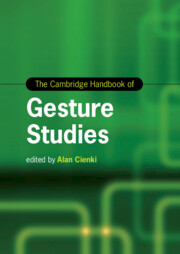Book contents
- The Cambridge Handbook of Gesture Studies
- Cambridge Handbooks in Language and Linguistics
- The Cambridge Handbook of Gesture Studies
- Copyright page
- Contents
- Figures
- Tables
- Contributors
- Introduction
- Part I Gestural Types: Forms and Functions
- Part II Ways of Approaching Gesture Analysis
- Part III Gestures and Language
- Part IV Gestures in Relation to Cognition
- Part V Gestures in Relation to Interaction
- 22 Gesturing for the Addressee
- 23 Gesture and Intersubjectivity
- 24 Variation in Gesture: A Sociocultural Linguistic Perspective
- 25 Communicative Gesturing in Interaction with Robots
- 26 Gestural Interfaces in Human–Computer Interaction
- Index
- References
22 - Gesturing for the Addressee
from Part V - Gestures in Relation to Interaction
Published online by Cambridge University Press: 01 May 2024
- The Cambridge Handbook of Gesture Studies
- Cambridge Handbooks in Language and Linguistics
- The Cambridge Handbook of Gesture Studies
- Copyright page
- Contents
- Figures
- Tables
- Contributors
- Introduction
- Part I Gestural Types: Forms and Functions
- Part II Ways of Approaching Gesture Analysis
- Part III Gestures and Language
- Part IV Gestures in Relation to Cognition
- Part V Gestures in Relation to Interaction
- 22 Gesturing for the Addressee
- 23 Gesture and Intersubjectivity
- 24 Variation in Gesture: A Sociocultural Linguistic Perspective
- 25 Communicative Gesturing in Interaction with Robots
- 26 Gestural Interfaces in Human–Computer Interaction
- Index
- References
Summary
Face-to-face dialogue and the cospeech gestures that occur within it are social as well as cognitive. Cospeech gestures are microsocial. Some of these gestures provide information that directly advances the topic of a dialogue. Others inform addressee about the state of the dialogue at that moment. Efron distinguished between objective and logical-discursive gestures. McNeill distinguished between propositional gestures and beats. Bavelas et al. distinguished between topical and interactive functions of gestures. Gerwing documented changes in form that marked gestures that were part of common ground. Seyfeddinipur identified discursive and meta-discursive gestures. Kendon described a variety of social, pragmatic gestures. Holler and Wilkin showed that mimicking a gesture conveyed understanding of that gesture. Galati and Brennan noted metanarrative functions of gestures. Kok et al. separated semantic and metacommunicative gestures. We focus on Clark’s distinction between track 1 and track 2 functions in dialogue. Track 1 conveys the basic communicative acts (i.e. topical content) whereas track 2 conveys the metacommunicative acts that ensure successful communication.
- Type
- Chapter
- Information
- The Cambridge Handbook of Gesture Studies , pp. 579 - 598Publisher: Cambridge University PressPrint publication year: 2024

